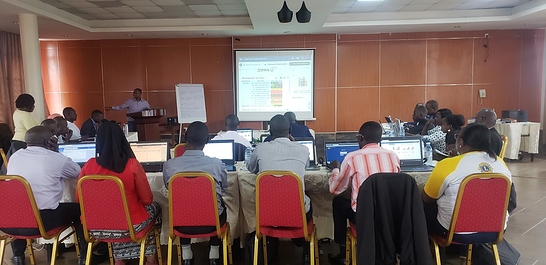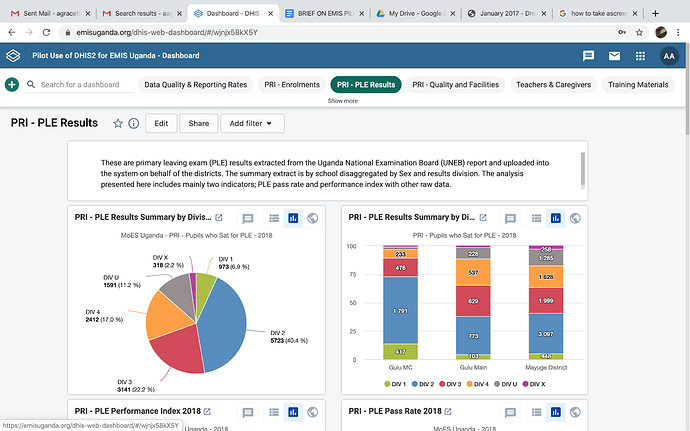DHIS2 Beyond Health in Uganda
Education Management Information System (EMIS)
The Ministry of Health (MoH) Uganda adopted DHIS2 as a Health Management Information System (HMIS), and has used DHIS2 as the national platform for reporting health data for several years. Establishing and maintaining a robust implementation of DHIS2 on a national scale required MoH Uganda to build capacity at different levels. 135 district teams and over 300 district hospitals and health facilities across the country have been equipped and trained to use DHIS2 to capture, validate, analyse, and present health information. At national level, this large-scale implementation has been sustained with support from HISP Uganda (part of the Health Informatics Systems Programme), University of Oslo, and other partners. HISP Uganda’s expertise in the use of DHIS2 for health information has benefited other sectors such as environment and education.
Since June 2019, the Ministry of Education and Sports (MoES) basic education department has been piloting the use of DHIS2 as an Education Management Information System (EMIS) in the Gulu and Mayuge districts. This one-year project has been carried out with technical support from HISP Uganda and Save the Children Uganda, financial support from the University of Oslo and funding from the Norwegian Agency for Development Cooperation (NORAD).
The pilot aimed to leverage HISP Uganda’s national- and district-level DHIS2 expertise to build capacity in the education sector to improve data capture and quality, and to increase data utilization at all levels with a goal of supporting the monitoring of key performance indicators, and guiding decision making, prioritization and allocation of resources. Specific objectives of the pilot included:
- Building capacity of MoES staff to sustainably manage, maintain and use the DHIS2-EMIS system.
- Building capacity of district leadership and education teams to collect, enter, validate, analyze and use data from the DHIS2-EMIS for evidence-based planning.
- Evaluate the potential to scale-up and use the system across all districts with support of the district health sector
Processes:
- Secured buy-in from various stakeholders, including MoES Permanent Secretary (PS) and Hon. Minister of Education for state - Primary education, Basic Education technical working group, district leadership and implementing partners. The MoES PS has approved the continuation of the pilot and KIX research initiative working closely with MoES ICT and Planning and Policy Departments.
- EMIS reporting, processing and data use requirements were jointly collected and documented by HISP Uganda, Save the Children Uganda, MoES (Basic Education and Statistics) and district teams from school to district and to national levels. This was achieved through field visits to districts and schools.
- Trained MoES central-level staff, district Education officers, district planners, inspectors of schools and health sector districts teams on data entry, validation, analysis and presentation using the DHIS2-EMIS system.
- Each pilot district was equipped with a laptop, desktop, UPS and shared wireless internet to support district-level data entry into DHIS2-EMIS.
- The districts entered 2016 and 2017 data from the previous annual school census carried out by the MoES. Since MoES had not conducted the census for 2018, the district school inspectors distributed annual school statistical forms and schools collected 2018 data which was entered in the DHIS2-EMIS. In addition, the Uganda National Examination Board (UNEB) results from primary school completion examinations were imported into the system to support analysis of performance indicators on quality, accessibility and effectiveness of education service delivery at district level.
- After a successful data entry and validation exercise, conducted more capacity-building training for both MoES and district Education staff in data analysis, presentation and interpretation for use. A three-day, hands-on data DHIS2 analytics training was conducted for District Education officers, inspectors of schools and education officers together with their counterparts from health (biostatisticians).
District Education teams during the hands on data presentation and use training in October 2019
Pilot Achievements
- Improved data use at district level: The districts have not only gained capacity in collecting, entering and analysing data, but have also utilised the data collected for planning. In Gulu district, the 2018 EMIS data was used to inform the development of 2020/2021 budget and the Gulu district development plan. Data from DHIS2-EMIS was also used to support the health department in planning for the 2019 Measles, Rubella, polio immunisation campaign in Gulu and Mayuge districts.
- In addition to reducing the paperwork burden, the DHIS2-EMIS system has also made data/information available at just the click of the button. The district dashboards have been a game-changer for the district education team who have always been inspired by DHIS2-HMIS for health dashboards shared by their counterparts from the Health sector during district meetings. The presentation of dashboards with major indicators on accessibility, quality and efficiency have made reporting on key indicators in the education sector much easier at the district level.
Dashboards showing key performance indicators
- Provision of hardware and software; desktops, laptops and wireless internet at the district-level has eased communication between district departments, both within and beyond the education sector.
- Benefiting the core DHIS2 development with new generic functionality developed for education as well as other programs and implementations: During the pilot, core DHIS2 developers identified and developed a number of new requirements and fixed several bugs with the core software.
Implementation challenges
- Due to lack of a policy in Uganda that enforces reporting in private schools, both districts recorded very low reporting rates from private schools compared to 100% from public schools. The reporting rate for government schools was at 96.4% compared to 19.5% for private schools in 2018 and 86.4% for government schools and 17.6% for private schools in 2017. Low reporting rates are attributed to the lack of allocation of capitation grants to private schools.
- Poor record keeping at both district and school level and failure of some school administrators to fill the EMIS statistical form correctly. This may have been due to the limited data analysis at district level, since previously all the data was entered and analyzed at national level.
- Challenges in validating and verifying previous data by districts. The majority of the source records at schools are not available, and most of the administrators who supported the aggregation of those data were transferred to other schools.
- Poor storage of hard copies of the statistical forms, with lack of files and filing cabins at both school and district level.
- Unlike the district health sector that has a dedicated statistical person for data, the district education sector lacks a statistician to support the district education officers in management of data.
- Lack of both primary data collection and summary tools at schools due lack of funds for printing, distribution, collection and submitting to districts.
Lessons learnt
- There is an increased demand for district EMIS data ownership, management, and use similar to the health sector which the DHIS2 for EMIS pilot has been able to provide. For most of the countries, EMIS data has been centrally collected, captured, analysed and managed and districts have found it difficult to access and use.
- Support for EMIS needs to be decentralized to districts (similar to the health sector), which will necessitate allocation of a budget to support EMIS activities at the district level
- Data management and statistical capacity needs to be strengthened for the district education sector by providing for a statistician to support management and use of EMIS data at district level.
- The districts have the capacity to collect, analyse and use data. It is also possible to use the existing DHIS2 capacity in the health sector to cascade, scale up and facilitate use of DHIS2 for education.
- Timely dissemination of information/feedback at all levels including districts, schools, community and Parent-Teacher Associations promotes a culture of data demand and use.
- Shared internet beyond EMIS data management support. The shared internet connecting up to a maximum of 30 devices proved cost effective (about 70 USD per month per district) and facilitated easy communication between different departments. At some implementing sites, the wireless internet has been used; for HMIS (dhis2) data reporting and management by the health department and to support district planning and procurement.
- The high level of global, regional, national and subnational DHIS2 capacity makes implementation of DHIS2 beyond health seamlessly easy and cost effective. Uganda, like many other countries has developed capacity in HISP groups, Ministry of Health, districts and health facilities that have been key in implementing DHIS2 in the Education sector.
- Implementation of aggregate-level EMIS data capture in Uganda has been very successful for the pilot districts, and this could easily transition to finer/more granular data through the implementation of DHIS2 Tracker, which supports individual-level records (as well as online and offline data entry via web and android)
Based on the results of the Uganda pilot, DHIS2-EMIS country scale-up is attainable with a manageable budget and minimal resources for maintenance after scale. Key elements of the initial budget would include procurement and installation of equipment, internet connectivity, salaries, capacity building ,support and supervision for both the district and MoES teams.


